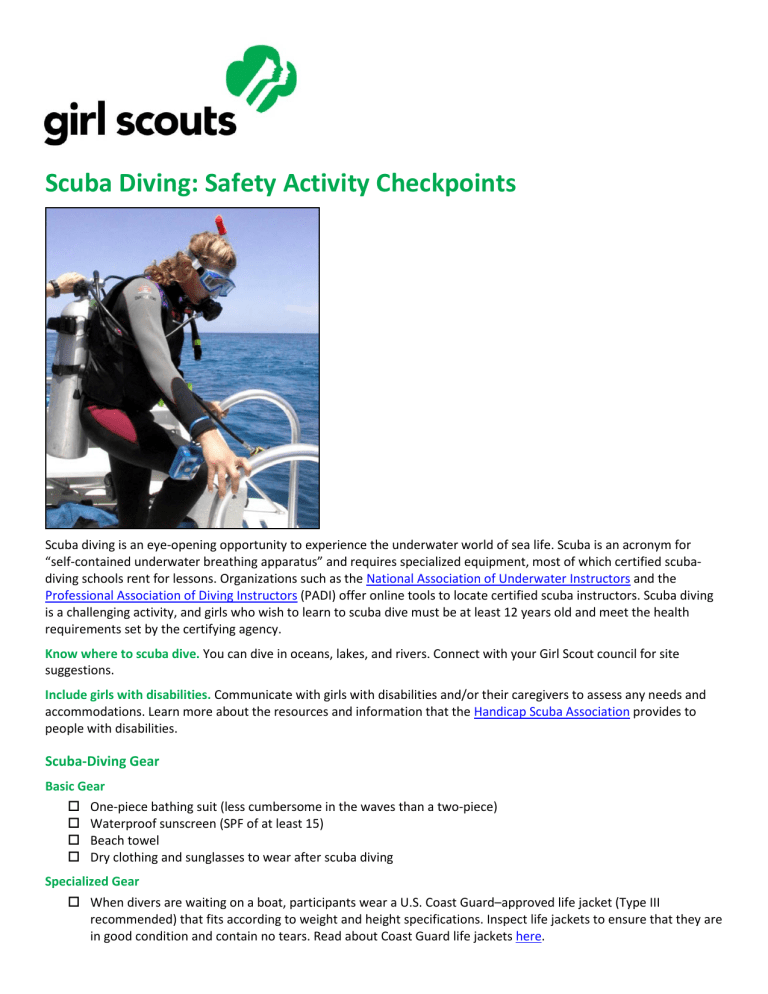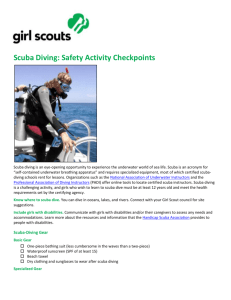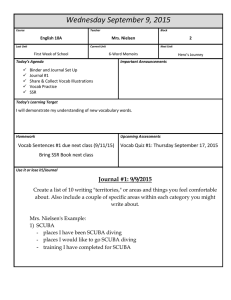Safety Activity Checkpoint: Scuba Diving

Scuba Diving: Safety Activity Checkpoints
Scuba diving is an eye-opening opportunity to experience the underwater world of sea life. Scuba is an acronym for
“self-contained underwater breathing apparatus” and requires specialized equipment, most of which certified scubadiving schools rent for lessons. Organizations such as the National Association of Underwater Instructors and the
Professional Association of Diving Instructors (PADI) offer online tools to locate certified scuba instructors. Scuba diving is a challenging activity, and girls who wish to learn to scuba dive must be at least 12 years old and meet the health requirements set by the certifying agency.
Know where to scuba dive.
You can dive in oceans, lakes, and rivers. Connect with your Girl Scout council for site suggestions.
Include girls with disabilities.
Communicate with girls with disabilities and/or their caregivers to assess any needs and accommodations. Learn more about the resources and information that the Handicap Scuba Association provides to people with disabilities.
Scuba-Diving Gear
Basic Gear
One-piece bathing suit (less cumbersome in the waves than a two-piece)
Waterproof sunscreen (SPF of at least 15)
Beach towel
Dry clothing and sunglasses to wear after scuba diving
Specialized Gear
When divers are waiting on a boat, participants wear a U.S. Coast Guard–approved life jacket (Type III recommended) that fits according to weight and height specifications. Inspect life jackets to ensure that they are in good condition and contain no tears. Read about Coast Guard life jackets here .
Wetsuit or dive skin
Air tank
Underwater compass, depth gauge, temperature gauge, bottom clock
Snorkel
Weight belt (weights help a diver descend into water)
Floating dive flag
Mask
Mask defogger solution
Fins
Gloves
Regulator
Writing slate and pencil
Lights
At least one graspable and personal flotation device (Type IV buoyant cushion or ring buoy or equivalent) is immediately available for each group on the water
Prepare for Scuba Diving
Communicate with council and parents.
Inform Girl Scout council and parents/guardians about the activity, including details about safety precautions and any appropriate clothing or supplies that may be necessary.
Follow council procedures for activity approval, certificates of insurance, and council guidelines about girls’ general health examinations. Make arrangements in advance for all transportation and confirm plans before departure.
Girls plan the activity.
Keeping their grade-level abilities in mind, encourage girls to take proactive leadership roles in organizing details of the activity.
Ensure participants are able to swim.
Participants’ swimming abilities are classified and clearly identified (for instance, with colored headbands to signify beginners, advanced swimmers, etc.) at council-approved sites, or participants provide proof of swimming-test certification. In the absence of swimming-test certification, a swim test is conducted on the day of the activity. Consult with your Girl Scout council for additional guidance.
Arrange for transportation and adult supervision.
The recommended adult-to-girl ratios are two non-related adults (at least one of whom is female) to every:
• 20 Girl Scout Cadettes
• 24 Girl Scout Seniors
• 24 Girl Scout Ambassadors
Plus one adult to each additional:
• 10 Girl Scout Cadettes
• 12 Girl Scout Seniors
• 12 Girl Scout Ambassadors
Verify instructor knowledge and experience.
Ensure that the scuba-diving teacher holds instructional certification from Scuba Schools International (SSI), PADI, the National Association of Underwater Instructors
(NAUI), or the YMCA. The instructor-to-girl ratio is one to four.
Compile key contacts.
Give an itinerary to a contact person at home; call the contact person upon departure and return. Create a list of girls’ parents/guardian contact information, telephone numbers for emergency services and police, and council contacts—keep on hand or post in an easily accessible location.
Size up scuba gear. Communicate girls’ ages, heights, and weights to instructors and equipment providers to ensure the appropriate size of scuba gear is available. Be sure that the instructor and participants check equipment before use.
Safeguard valuables.
Don’t leave personal belongings and valuables unattended in a public place. If working with a scuba-diving school or camp, inquire about the organization’s storage amenities.
Prepare for emergencies.
Ensure the presence of a waterproof first-aid kit and a first-aider with a current certificate in First Aid, including Adult and Child CPR or CPR/AED, who is prepared to handle cases of neardrowning, immersion hypothermia, and sunburn. If any part of the activity is located 60 minutes or more from emergency medical services, ensure the presence of a first-aider (level 2) with Wilderness and Remote First Aid.
See Volunteer Essentials for information about first-aid standards and training.
On the Day of Scuba Diving
Get a weather and wind report.
Never scuba dive on a stormy or extremely windy day. On the day of the scubadiving trip or lesson, check weather.com
, www.
scubabyte.com
, or other reliable weather sources to determine if conditions are appropriate. If weather conditions prevent the scuba-diving trip, be prepared with a backup plan or alternate activity.
Use the buddy system.
Girls are divided into teams of two. Each girl chooses a buddy and is responsible for staying with her buddy at all times, warning her buddy of danger, giving her buddy immediate assistance if safe to do so, and seeking help when the situation warrants it. If someone in the group is injured, one person cares for the patient while two others seek help.
Be prepared in the event of a storm with lightning . Exit water immediately, and take shelter away from tall objects (including trees, buildings, and electrical poles). Find the lowest point in an open flat area. Squat low to the ground on the balls of the feet, and place hands on knees with head between them.
Scuba-Diving Links
• National Association of Underwater Instructors (NAUI): www.naui.org
• Professional Association of Diving Instructors (PADI): www.padi.com
• Scuba Schools International: www.divessi.com
• Scuba Diving Magazine: www.scubadiving.com
Scuba-Diving Know-How for Girls
• Learn how to conserve oxygen while diving.
Learning about energy-saving techniques that may help extend your diving experience.
• Protect ears.
Underwater pressure can irritate ears; learn how to prevent discomfort .
Scuba-Diving Jargon
• Backward roll entry: Entering water from a sitting position from the edge of a boat, whereby the diver leans backward and rolls into the water onto the tank and shoulders
• Giant stride entry: Entering water by stepping off of a secure platform; the safest and most common method for divers to enter water
• Undertow: Current beneath surface of water that sweeps seaward or along a beach when waves are breaking on shore





